Research Proposal on Adelaide Air Traffic Control
VerifiedAdded on 2023/06/07
|12
|2141
|91
AI Summary
This research proposal focuses on the operating system of Adelaide Air Traffic Control and the issues faced during its operations. It aims to identify the reasons behind the disruptive operations of the ATC tower and find solutions to control them. The research methodology includes descriptive research design, survey research strategy, and secondary data collection technique. The significance of the research lies in identifying the different types of problems faced by the operators of Adelaide Air Traffic Control Tower.
Contribute Materials
Your contribution can guide someone’s learning journey. Share your
documents today.
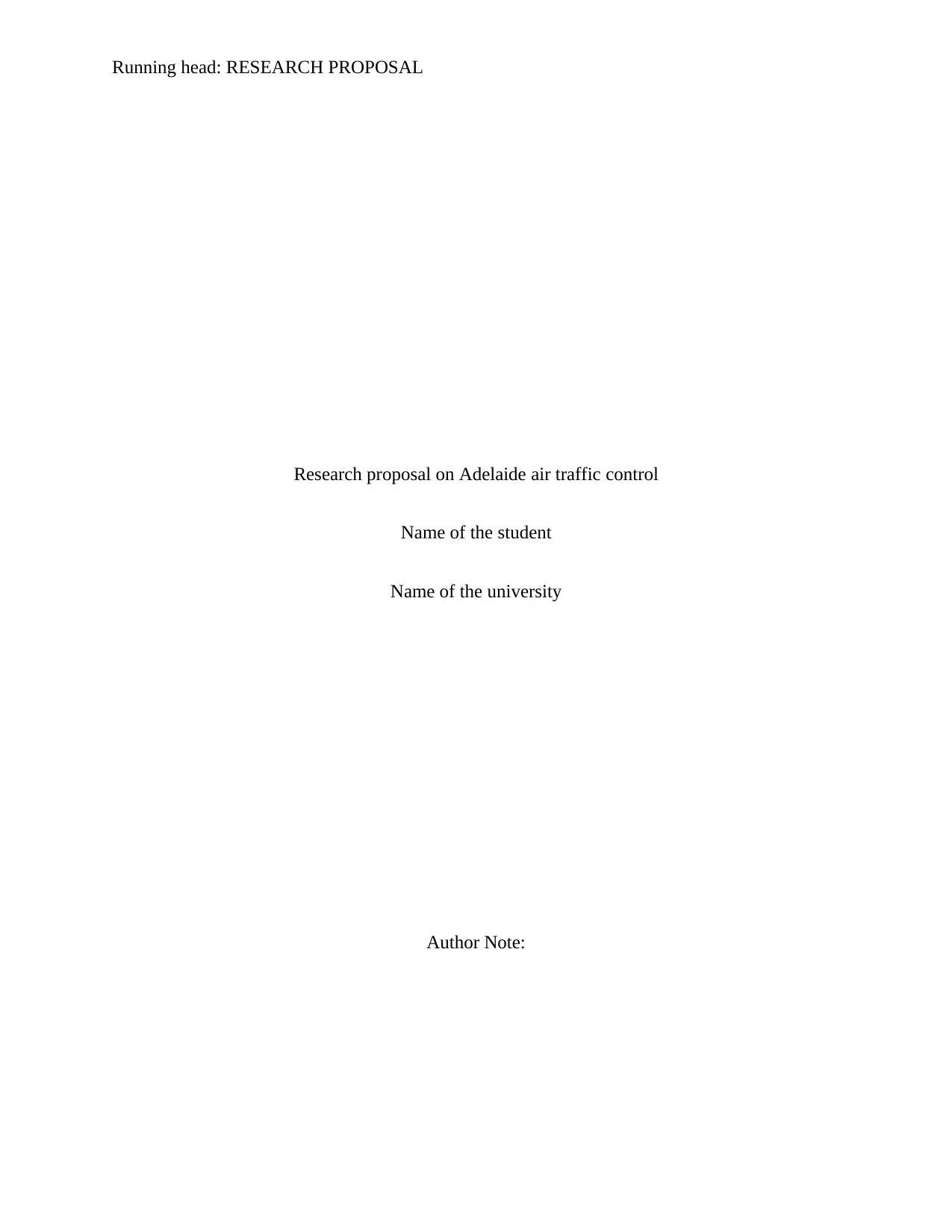
Running head: RESEARCH PROPOSAL
Research proposal on Adelaide air traffic control
Name of the student
Name of the university
Author Note:
Research proposal on Adelaide air traffic control
Name of the student
Name of the university
Author Note:
Secure Best Marks with AI Grader
Need help grading? Try our AI Grader for instant feedback on your assignments.
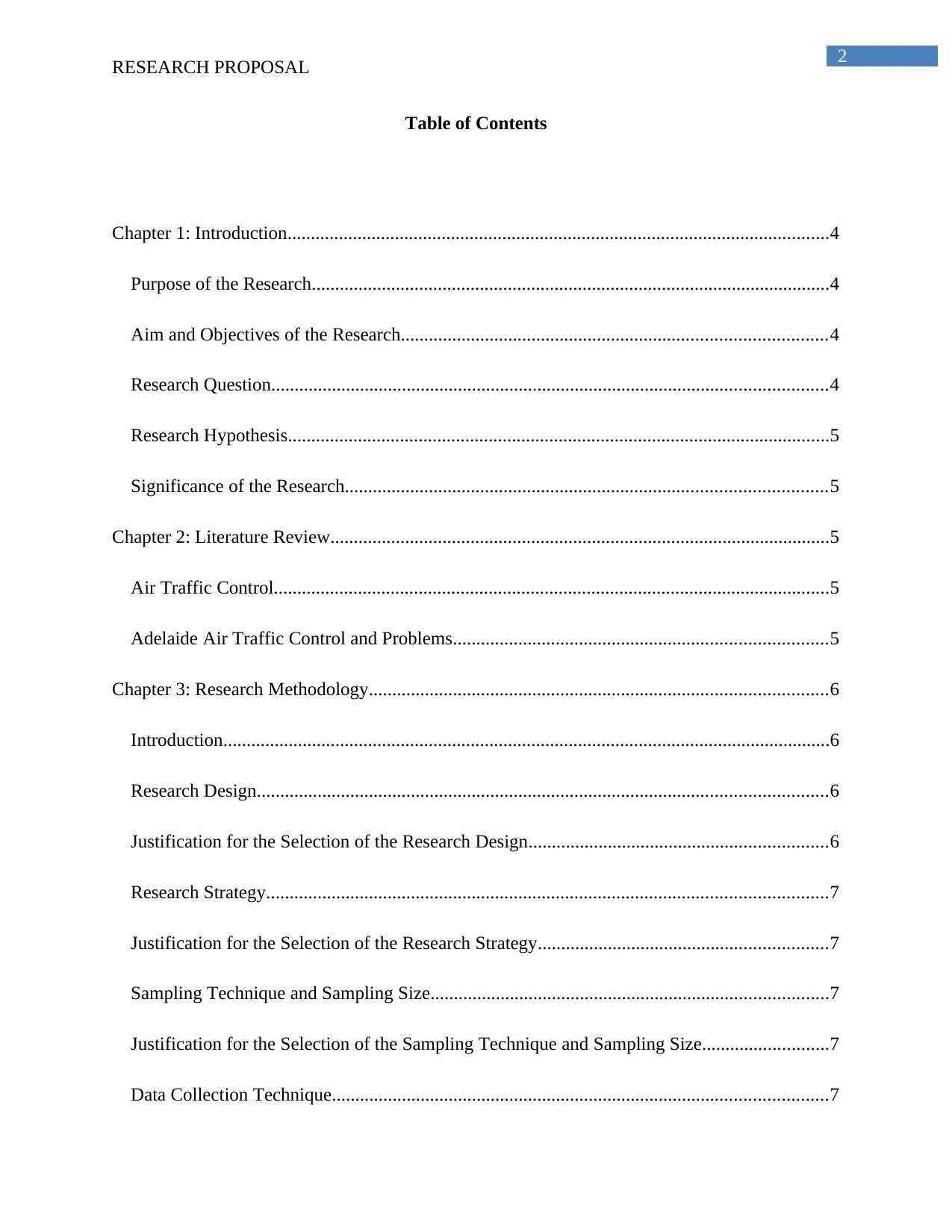
2
RESEARCH PROPOSAL
Table of Contents
Chapter 1: Introduction....................................................................................................................4
Purpose of the Research...............................................................................................................4
Aim and Objectives of the Research...........................................................................................4
Research Question.......................................................................................................................4
Research Hypothesis....................................................................................................................5
Significance of the Research.......................................................................................................5
Chapter 2: Literature Review...........................................................................................................5
Air Traffic Control.......................................................................................................................5
Adelaide Air Traffic Control and Problems................................................................................5
Chapter 3: Research Methodology..................................................................................................6
Introduction..................................................................................................................................6
Research Design..........................................................................................................................6
Justification for the Selection of the Research Design................................................................6
Research Strategy........................................................................................................................7
Justification for the Selection of the Research Strategy..............................................................7
Sampling Technique and Sampling Size.....................................................................................7
Justification for the Selection of the Sampling Technique and Sampling Size...........................7
Data Collection Technique..........................................................................................................7
RESEARCH PROPOSAL
Table of Contents
Chapter 1: Introduction....................................................................................................................4
Purpose of the Research...............................................................................................................4
Aim and Objectives of the Research...........................................................................................4
Research Question.......................................................................................................................4
Research Hypothesis....................................................................................................................5
Significance of the Research.......................................................................................................5
Chapter 2: Literature Review...........................................................................................................5
Air Traffic Control.......................................................................................................................5
Adelaide Air Traffic Control and Problems................................................................................5
Chapter 3: Research Methodology..................................................................................................6
Introduction..................................................................................................................................6
Research Design..........................................................................................................................6
Justification for the Selection of the Research Design................................................................6
Research Strategy........................................................................................................................7
Justification for the Selection of the Research Strategy..............................................................7
Sampling Technique and Sampling Size.....................................................................................7
Justification for the Selection of the Sampling Technique and Sampling Size...........................7
Data Collection Technique..........................................................................................................7
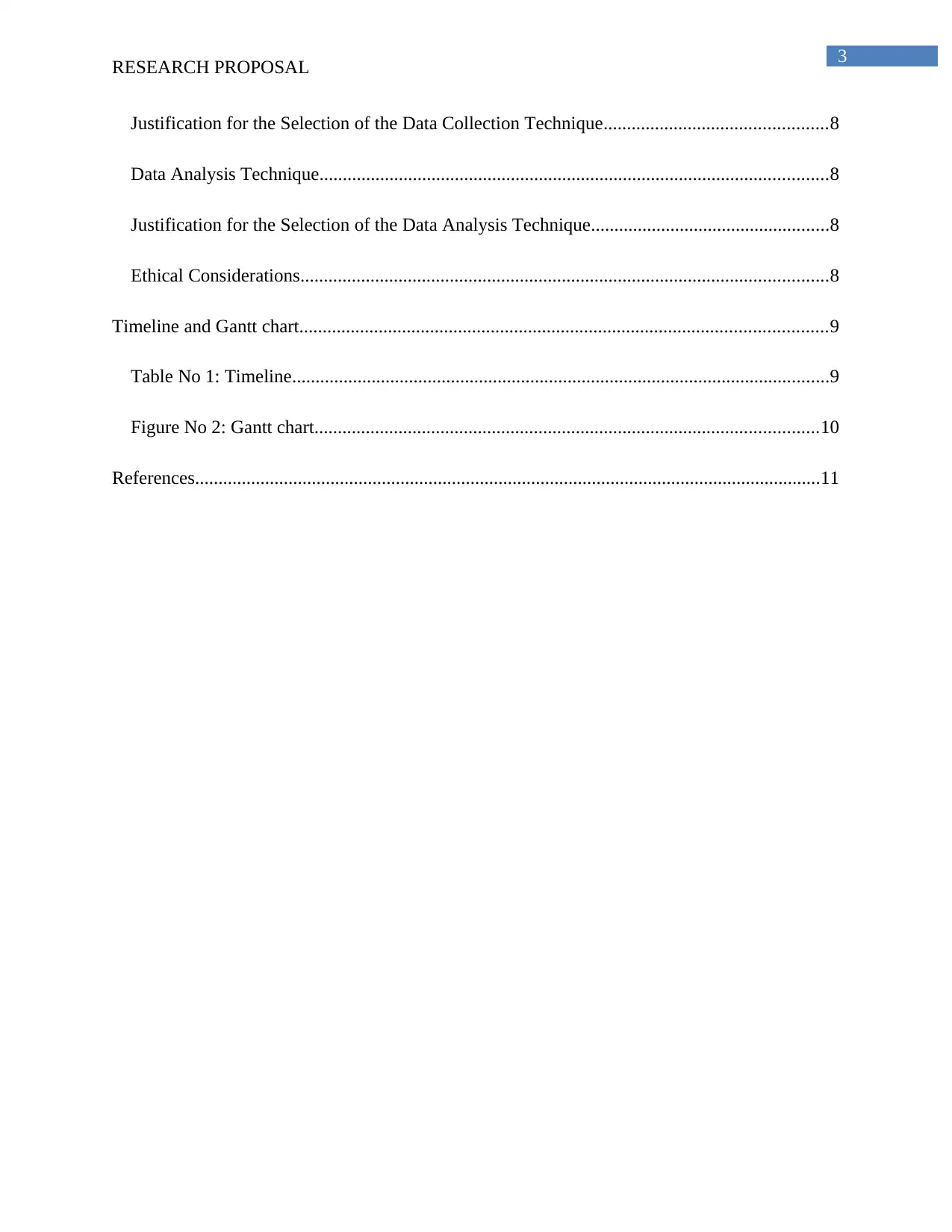
3
RESEARCH PROPOSAL
Justification for the Selection of the Data Collection Technique................................................8
Data Analysis Technique.............................................................................................................8
Justification for the Selection of the Data Analysis Technique...................................................8
Ethical Considerations.................................................................................................................8
Timeline and Gantt chart.................................................................................................................9
Table No 1: Timeline...................................................................................................................9
Figure No 2: Gantt chart............................................................................................................10
References......................................................................................................................................11
RESEARCH PROPOSAL
Justification for the Selection of the Data Collection Technique................................................8
Data Analysis Technique.............................................................................................................8
Justification for the Selection of the Data Analysis Technique...................................................8
Ethical Considerations.................................................................................................................8
Timeline and Gantt chart.................................................................................................................9
Table No 1: Timeline...................................................................................................................9
Figure No 2: Gantt chart............................................................................................................10
References......................................................................................................................................11
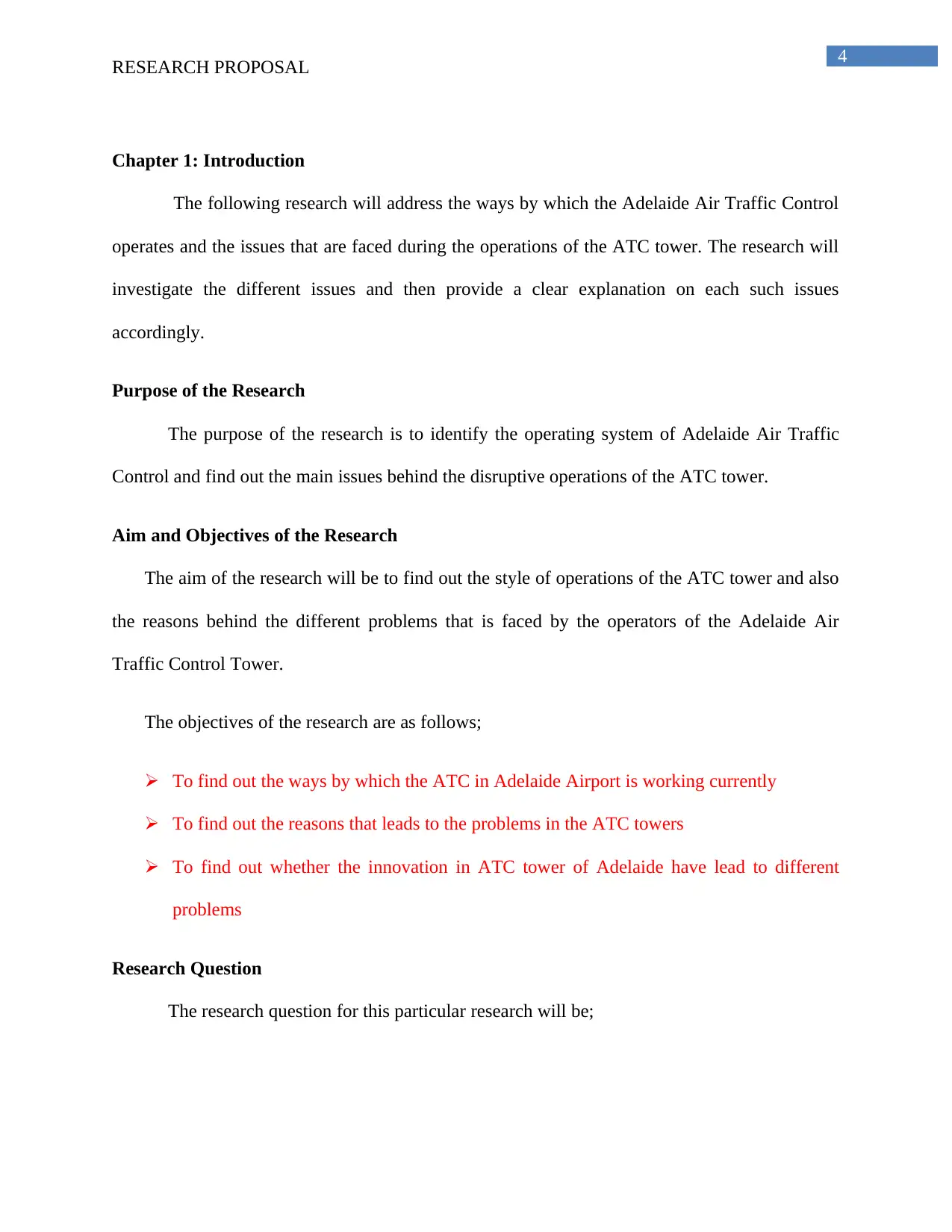
4
RESEARCH PROPOSAL
Chapter 1: Introduction
The following research will address the ways by which the Adelaide Air Traffic Control
operates and the issues that are faced during the operations of the ATC tower. The research will
investigate the different issues and then provide a clear explanation on each such issues
accordingly.
Purpose of the Research
The purpose of the research is to identify the operating system of Adelaide Air Traffic
Control and find out the main issues behind the disruptive operations of the ATC tower.
Aim and Objectives of the Research
The aim of the research will be to find out the style of operations of the ATC tower and also
the reasons behind the different problems that is faced by the operators of the Adelaide Air
Traffic Control Tower.
The objectives of the research are as follows;
To find out the ways by which the ATC in Adelaide Airport is working currently
To find out the reasons that leads to the problems in the ATC towers
To find out whether the innovation in ATC tower of Adelaide have lead to different
problems
Research Question
The research question for this particular research will be;
RESEARCH PROPOSAL
Chapter 1: Introduction
The following research will address the ways by which the Adelaide Air Traffic Control
operates and the issues that are faced during the operations of the ATC tower. The research will
investigate the different issues and then provide a clear explanation on each such issues
accordingly.
Purpose of the Research
The purpose of the research is to identify the operating system of Adelaide Air Traffic
Control and find out the main issues behind the disruptive operations of the ATC tower.
Aim and Objectives of the Research
The aim of the research will be to find out the style of operations of the ATC tower and also
the reasons behind the different problems that is faced by the operators of the Adelaide Air
Traffic Control Tower.
The objectives of the research are as follows;
To find out the ways by which the ATC in Adelaide Airport is working currently
To find out the reasons that leads to the problems in the ATC towers
To find out whether the innovation in ATC tower of Adelaide have lead to different
problems
Research Question
The research question for this particular research will be;
Secure Best Marks with AI Grader
Need help grading? Try our AI Grader for instant feedback on your assignments.
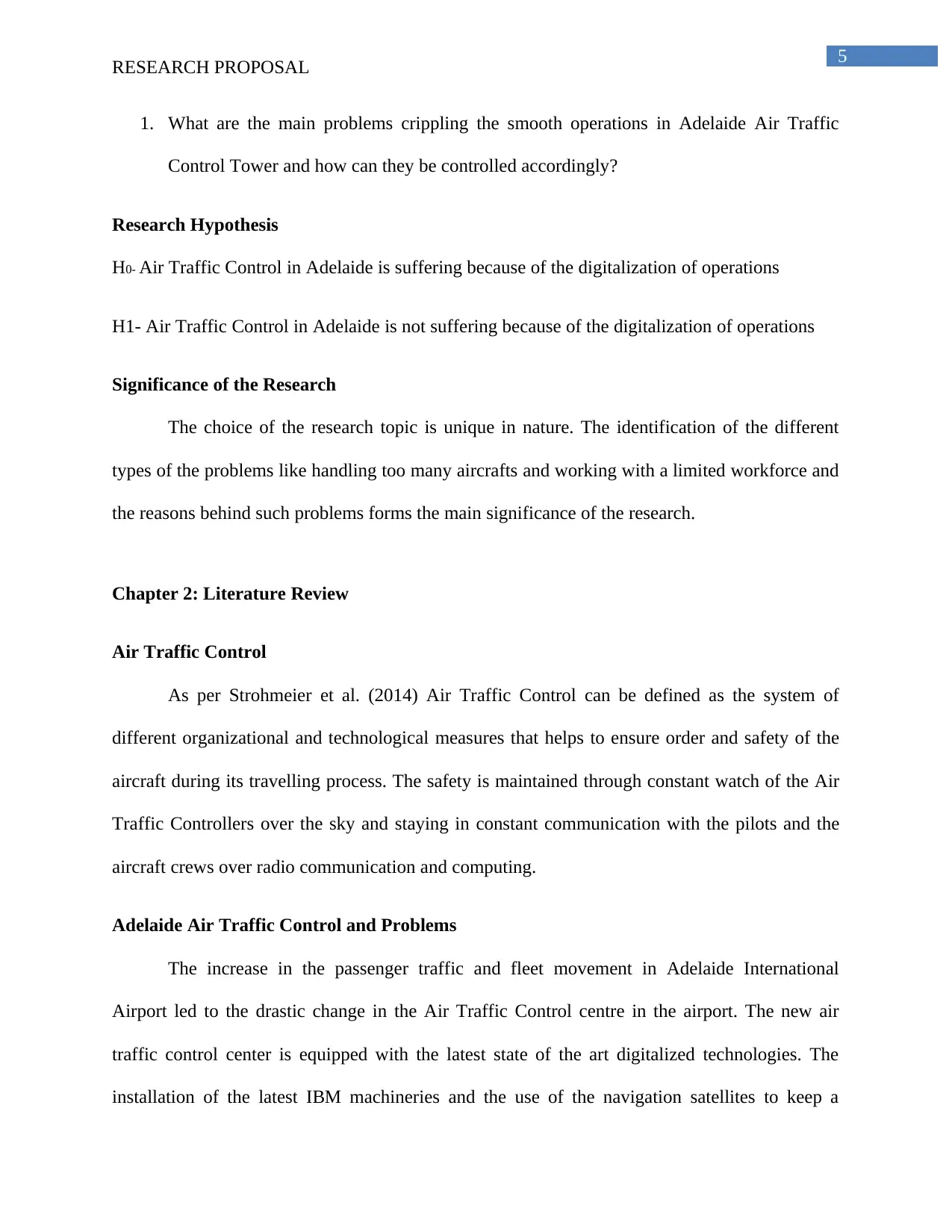
5
RESEARCH PROPOSAL
1. What are the main problems crippling the smooth operations in Adelaide Air Traffic
Control Tower and how can they be controlled accordingly?
Research Hypothesis
H0- Air Traffic Control in Adelaide is suffering because of the digitalization of operations
H1- Air Traffic Control in Adelaide is not suffering because of the digitalization of operations
Significance of the Research
The choice of the research topic is unique in nature. The identification of the different
types of the problems like handling too many aircrafts and working with a limited workforce and
the reasons behind such problems forms the main significance of the research.
Chapter 2: Literature Review
Air Traffic Control
As per Strohmeier et al. (2014) Air Traffic Control can be defined as the system of
different organizational and technological measures that helps to ensure order and safety of the
aircraft during its travelling process. The safety is maintained through constant watch of the Air
Traffic Controllers over the sky and staying in constant communication with the pilots and the
aircraft crews over radio communication and computing.
Adelaide Air Traffic Control and Problems
The increase in the passenger traffic and fleet movement in Adelaide International
Airport led to the drastic change in the Air Traffic Control centre in the airport. The new air
traffic control center is equipped with the latest state of the art digitalized technologies. The
installation of the latest IBM machineries and the use of the navigation satellites to keep a
RESEARCH PROPOSAL
1. What are the main problems crippling the smooth operations in Adelaide Air Traffic
Control Tower and how can they be controlled accordingly?
Research Hypothesis
H0- Air Traffic Control in Adelaide is suffering because of the digitalization of operations
H1- Air Traffic Control in Adelaide is not suffering because of the digitalization of operations
Significance of the Research
The choice of the research topic is unique in nature. The identification of the different
types of the problems like handling too many aircrafts and working with a limited workforce and
the reasons behind such problems forms the main significance of the research.
Chapter 2: Literature Review
Air Traffic Control
As per Strohmeier et al. (2014) Air Traffic Control can be defined as the system of
different organizational and technological measures that helps to ensure order and safety of the
aircraft during its travelling process. The safety is maintained through constant watch of the Air
Traffic Controllers over the sky and staying in constant communication with the pilots and the
aircraft crews over radio communication and computing.
Adelaide Air Traffic Control and Problems
The increase in the passenger traffic and fleet movement in Adelaide International
Airport led to the drastic change in the Air Traffic Control centre in the airport. The new air
traffic control center is equipped with the latest state of the art digitalized technologies. The
installation of the latest IBM machineries and the use of the navigation satellites to keep a
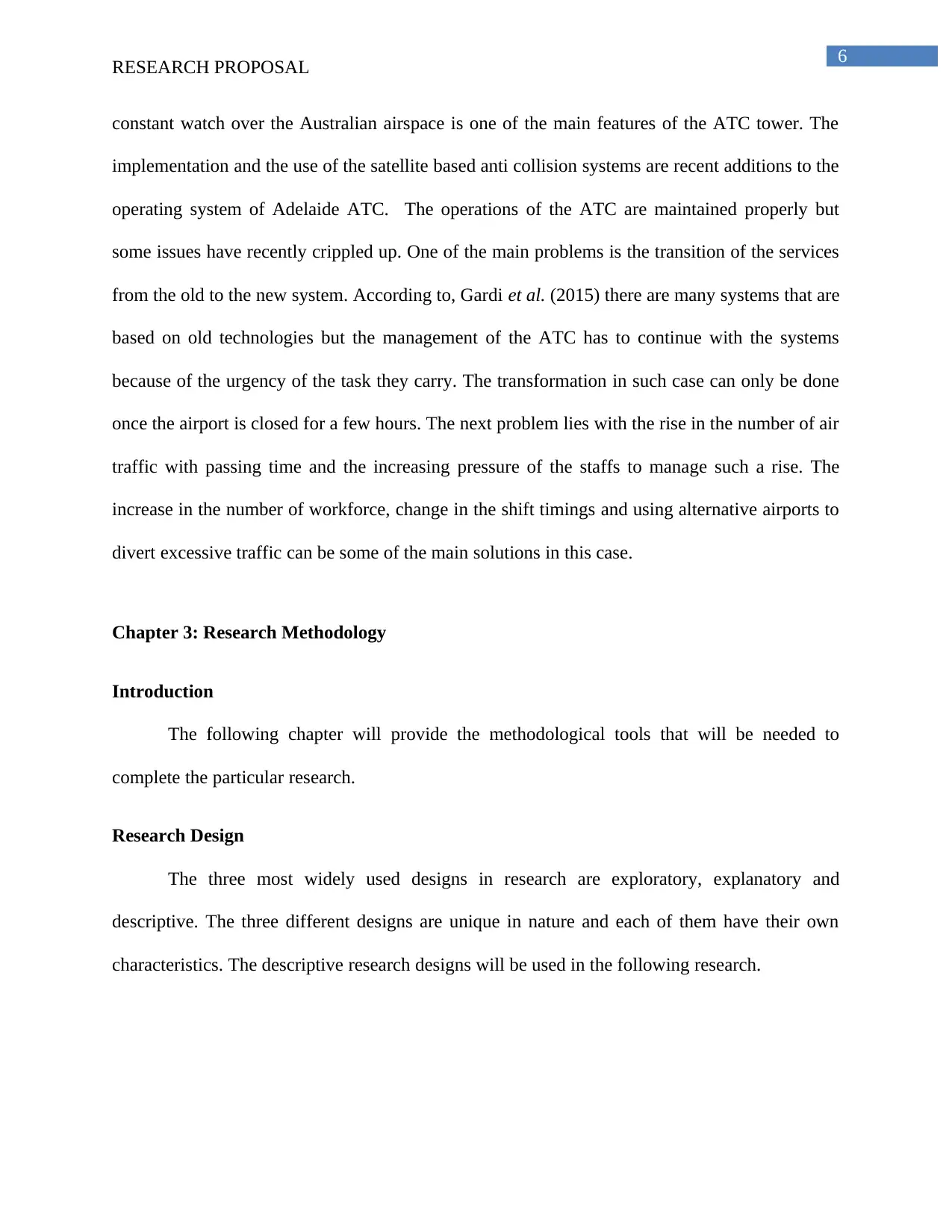
6
RESEARCH PROPOSAL
constant watch over the Australian airspace is one of the main features of the ATC tower. The
implementation and the use of the satellite based anti collision systems are recent additions to the
operating system of Adelaide ATC. The operations of the ATC are maintained properly but
some issues have recently crippled up. One of the main problems is the transition of the services
from the old to the new system. According to, Gardi et al. (2015) there are many systems that are
based on old technologies but the management of the ATC has to continue with the systems
because of the urgency of the task they carry. The transformation in such case can only be done
once the airport is closed for a few hours. The next problem lies with the rise in the number of air
traffic with passing time and the increasing pressure of the staffs to manage such a rise. The
increase in the number of workforce, change in the shift timings and using alternative airports to
divert excessive traffic can be some of the main solutions in this case.
Chapter 3: Research Methodology
Introduction
The following chapter will provide the methodological tools that will be needed to
complete the particular research.
Research Design
The three most widely used designs in research are exploratory, explanatory and
descriptive. The three different designs are unique in nature and each of them have their own
characteristics. The descriptive research designs will be used in the following research.
RESEARCH PROPOSAL
constant watch over the Australian airspace is one of the main features of the ATC tower. The
implementation and the use of the satellite based anti collision systems are recent additions to the
operating system of Adelaide ATC. The operations of the ATC are maintained properly but
some issues have recently crippled up. One of the main problems is the transition of the services
from the old to the new system. According to, Gardi et al. (2015) there are many systems that are
based on old technologies but the management of the ATC has to continue with the systems
because of the urgency of the task they carry. The transformation in such case can only be done
once the airport is closed for a few hours. The next problem lies with the rise in the number of air
traffic with passing time and the increasing pressure of the staffs to manage such a rise. The
increase in the number of workforce, change in the shift timings and using alternative airports to
divert excessive traffic can be some of the main solutions in this case.
Chapter 3: Research Methodology
Introduction
The following chapter will provide the methodological tools that will be needed to
complete the particular research.
Research Design
The three most widely used designs in research are exploratory, explanatory and
descriptive. The three different designs are unique in nature and each of them have their own
characteristics. The descriptive research designs will be used in the following research.
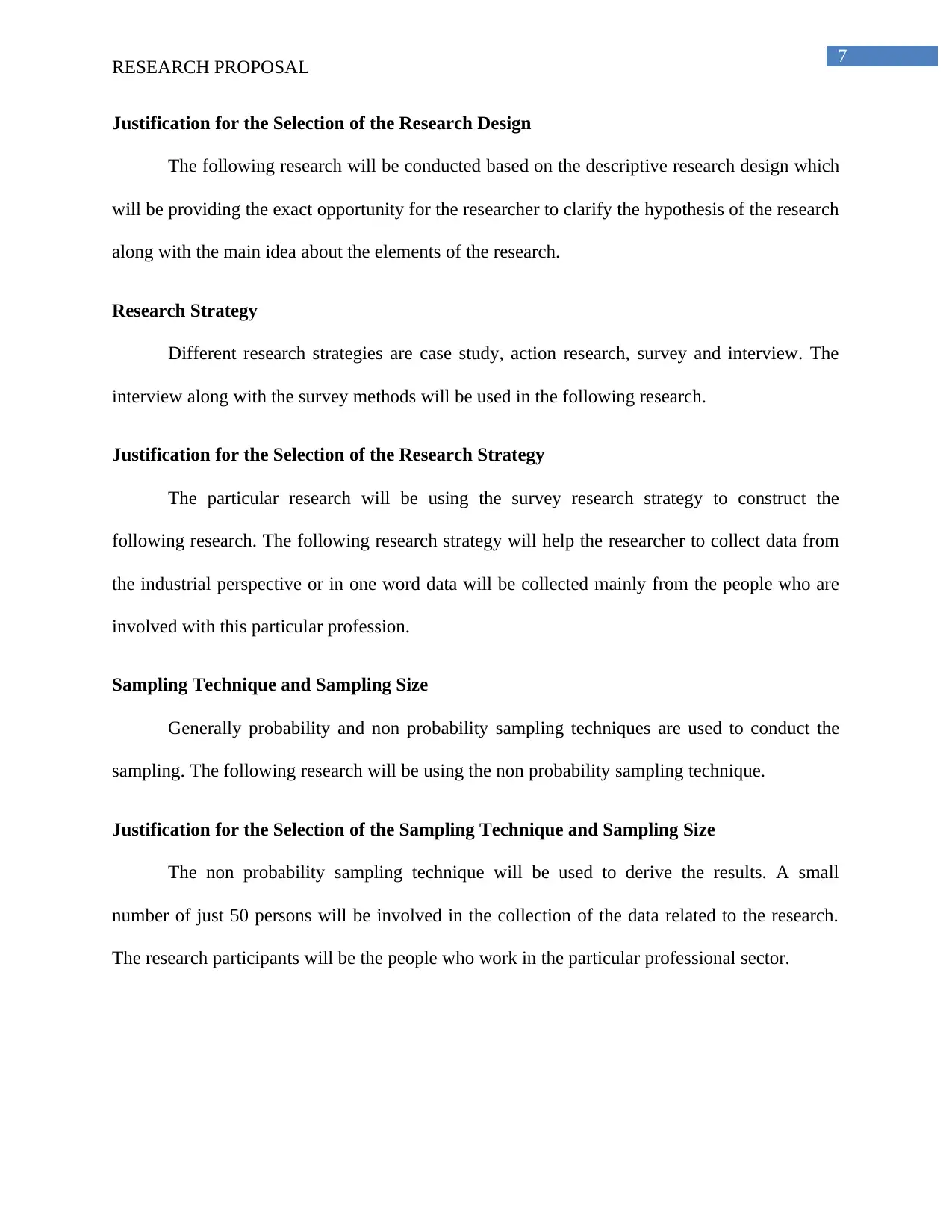
7
RESEARCH PROPOSAL
Justification for the Selection of the Research Design
The following research will be conducted based on the descriptive research design which
will be providing the exact opportunity for the researcher to clarify the hypothesis of the research
along with the main idea about the elements of the research.
Research Strategy
Different research strategies are case study, action research, survey and interview. The
interview along with the survey methods will be used in the following research.
Justification for the Selection of the Research Strategy
The particular research will be using the survey research strategy to construct the
following research. The following research strategy will help the researcher to collect data from
the industrial perspective or in one word data will be collected mainly from the people who are
involved with this particular profession.
Sampling Technique and Sampling Size
Generally probability and non probability sampling techniques are used to conduct the
sampling. The following research will be using the non probability sampling technique.
Justification for the Selection of the Sampling Technique and Sampling Size
The non probability sampling technique will be used to derive the results. A small
number of just 50 persons will be involved in the collection of the data related to the research.
The research participants will be the people who work in the particular professional sector.
RESEARCH PROPOSAL
Justification for the Selection of the Research Design
The following research will be conducted based on the descriptive research design which
will be providing the exact opportunity for the researcher to clarify the hypothesis of the research
along with the main idea about the elements of the research.
Research Strategy
Different research strategies are case study, action research, survey and interview. The
interview along with the survey methods will be used in the following research.
Justification for the Selection of the Research Strategy
The particular research will be using the survey research strategy to construct the
following research. The following research strategy will help the researcher to collect data from
the industrial perspective or in one word data will be collected mainly from the people who are
involved with this particular profession.
Sampling Technique and Sampling Size
Generally probability and non probability sampling techniques are used to conduct the
sampling. The following research will be using the non probability sampling technique.
Justification for the Selection of the Sampling Technique and Sampling Size
The non probability sampling technique will be used to derive the results. A small
number of just 50 persons will be involved in the collection of the data related to the research.
The research participants will be the people who work in the particular professional sector.
Paraphrase This Document
Need a fresh take? Get an instant paraphrase of this document with our AI Paraphraser
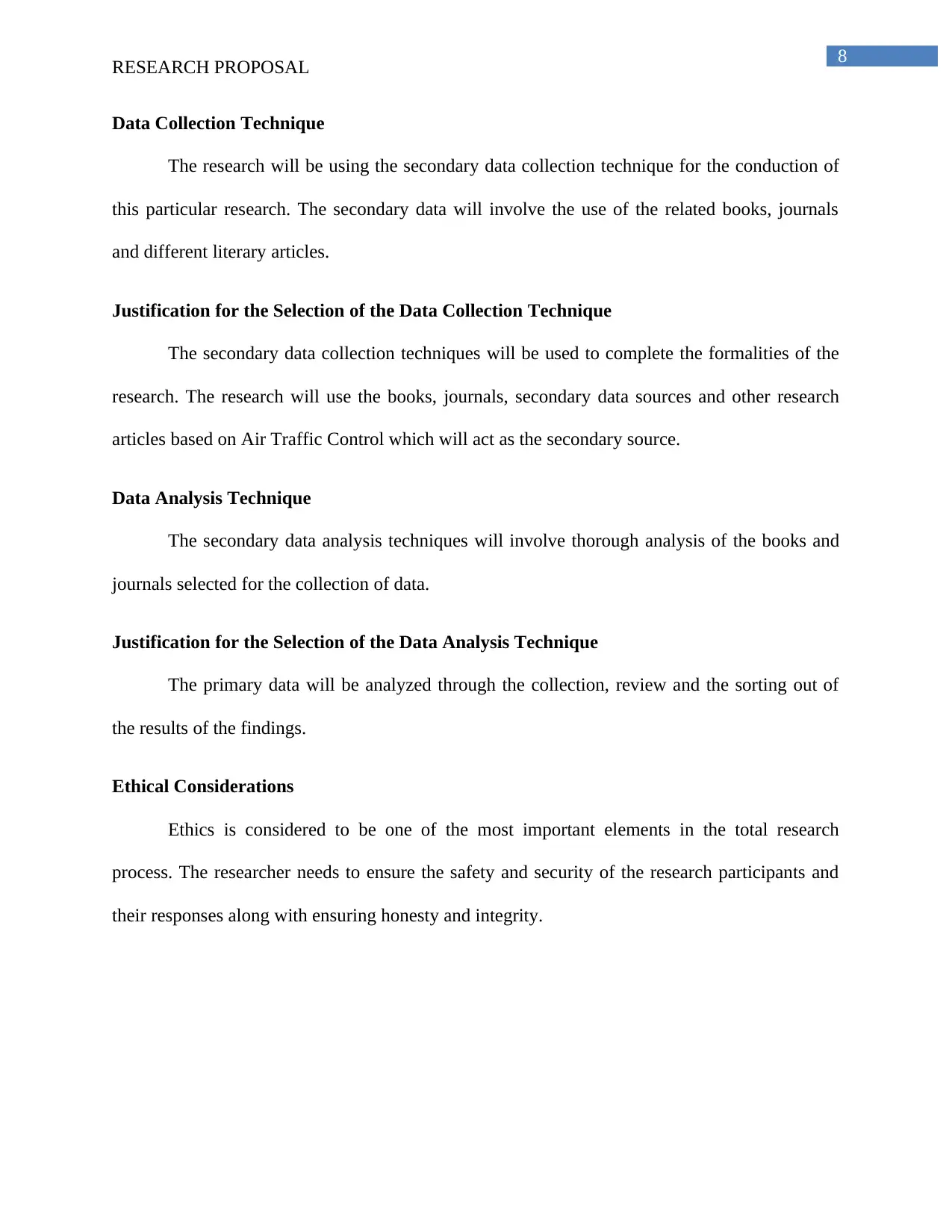
8
RESEARCH PROPOSAL
Data Collection Technique
The research will be using the secondary data collection technique for the conduction of
this particular research. The secondary data will involve the use of the related books, journals
and different literary articles.
Justification for the Selection of the Data Collection Technique
The secondary data collection techniques will be used to complete the formalities of the
research. The research will use the books, journals, secondary data sources and other research
articles based on Air Traffic Control which will act as the secondary source.
Data Analysis Technique
The secondary data analysis techniques will involve thorough analysis of the books and
journals selected for the collection of data.
Justification for the Selection of the Data Analysis Technique
The primary data will be analyzed through the collection, review and the sorting out of
the results of the findings.
Ethical Considerations
Ethics is considered to be one of the most important elements in the total research
process. The researcher needs to ensure the safety and security of the research participants and
their responses along with ensuring honesty and integrity.
RESEARCH PROPOSAL
Data Collection Technique
The research will be using the secondary data collection technique for the conduction of
this particular research. The secondary data will involve the use of the related books, journals
and different literary articles.
Justification for the Selection of the Data Collection Technique
The secondary data collection techniques will be used to complete the formalities of the
research. The research will use the books, journals, secondary data sources and other research
articles based on Air Traffic Control which will act as the secondary source.
Data Analysis Technique
The secondary data analysis techniques will involve thorough analysis of the books and
journals selected for the collection of data.
Justification for the Selection of the Data Analysis Technique
The primary data will be analyzed through the collection, review and the sorting out of
the results of the findings.
Ethical Considerations
Ethics is considered to be one of the most important elements in the total research
process. The researcher needs to ensure the safety and security of the research participants and
their responses along with ensuring honesty and integrity.
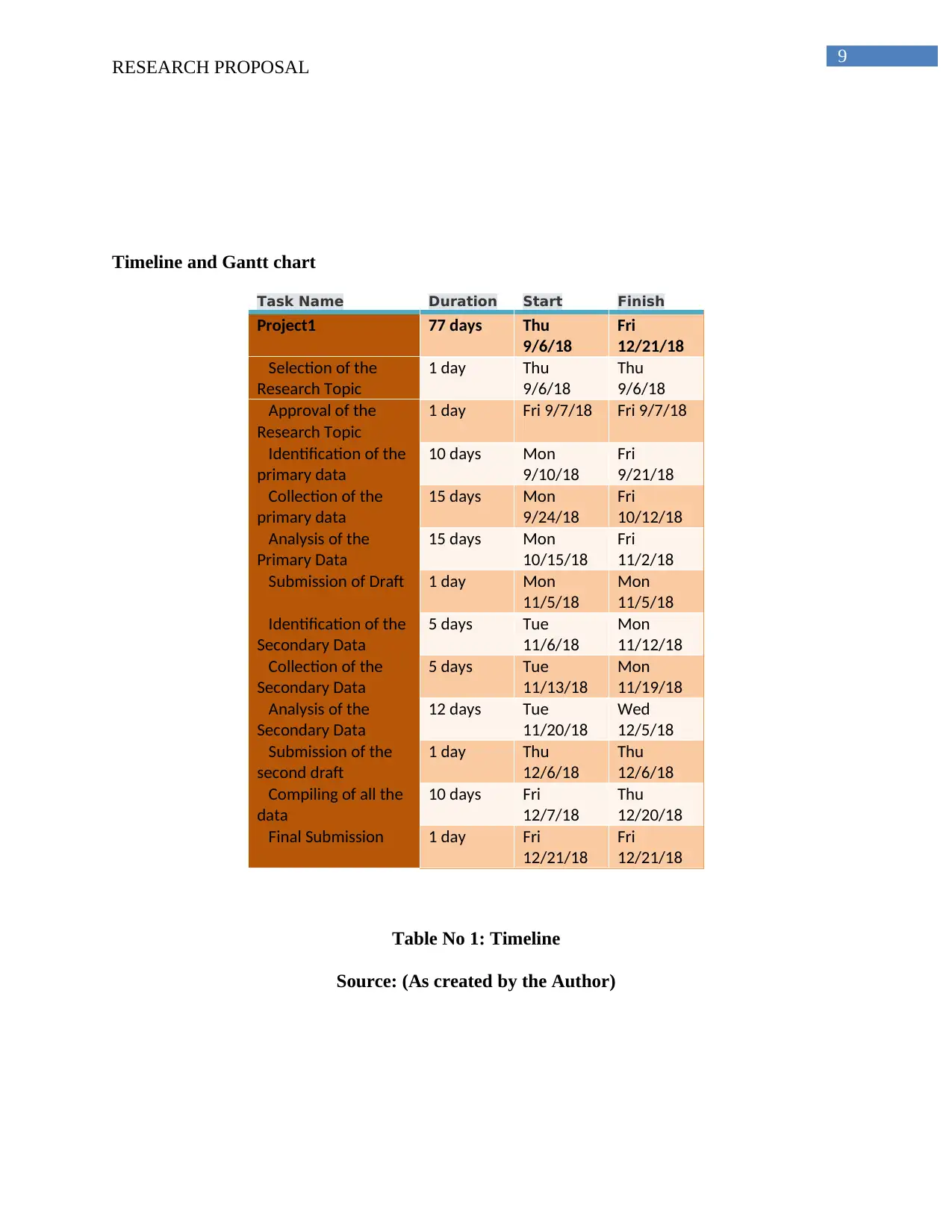
9
RESEARCH PROPOSAL
Timeline and Gantt chart
Task Name Duration Start Finish
Project1 77 days Thu
9/6/18
Fri
12/21/18
Selection of the
Research Topic
1 day Thu
9/6/18
Thu
9/6/18
Approval of the
Research Topic
1 day Fri 9/7/18 Fri 9/7/18
Identification of the
primary data
10 days Mon
9/10/18
Fri
9/21/18
Collection of the
primary data
15 days Mon
9/24/18
Fri
10/12/18
Analysis of the
Primary Data
15 days Mon
10/15/18
Fri
11/2/18
Submission of Draft 1 day Mon
11/5/18
Mon
11/5/18
Identification of the
Secondary Data
5 days Tue
11/6/18
Mon
11/12/18
Collection of the
Secondary Data
5 days Tue
11/13/18
Mon
11/19/18
Analysis of the
Secondary Data
12 days Tue
11/20/18
Wed
12/5/18
Submission of the
second draft
1 day Thu
12/6/18
Thu
12/6/18
Compiling of all the
data
10 days Fri
12/7/18
Thu
12/20/18
Final Submission 1 day Fri
12/21/18
Fri
12/21/18
Table No 1: Timeline
Source: (As created by the Author)
RESEARCH PROPOSAL
Timeline and Gantt chart
Task Name Duration Start Finish
Project1 77 days Thu
9/6/18
Fri
12/21/18
Selection of the
Research Topic
1 day Thu
9/6/18
Thu
9/6/18
Approval of the
Research Topic
1 day Fri 9/7/18 Fri 9/7/18
Identification of the
primary data
10 days Mon
9/10/18
Fri
9/21/18
Collection of the
primary data
15 days Mon
9/24/18
Fri
10/12/18
Analysis of the
Primary Data
15 days Mon
10/15/18
Fri
11/2/18
Submission of Draft 1 day Mon
11/5/18
Mon
11/5/18
Identification of the
Secondary Data
5 days Tue
11/6/18
Mon
11/12/18
Collection of the
Secondary Data
5 days Tue
11/13/18
Mon
11/19/18
Analysis of the
Secondary Data
12 days Tue
11/20/18
Wed
12/5/18
Submission of the
second draft
1 day Thu
12/6/18
Thu
12/6/18
Compiling of all the
data
10 days Fri
12/7/18
Thu
12/20/18
Final Submission 1 day Fri
12/21/18
Fri
12/21/18
Table No 1: Timeline
Source: (As created by the Author)
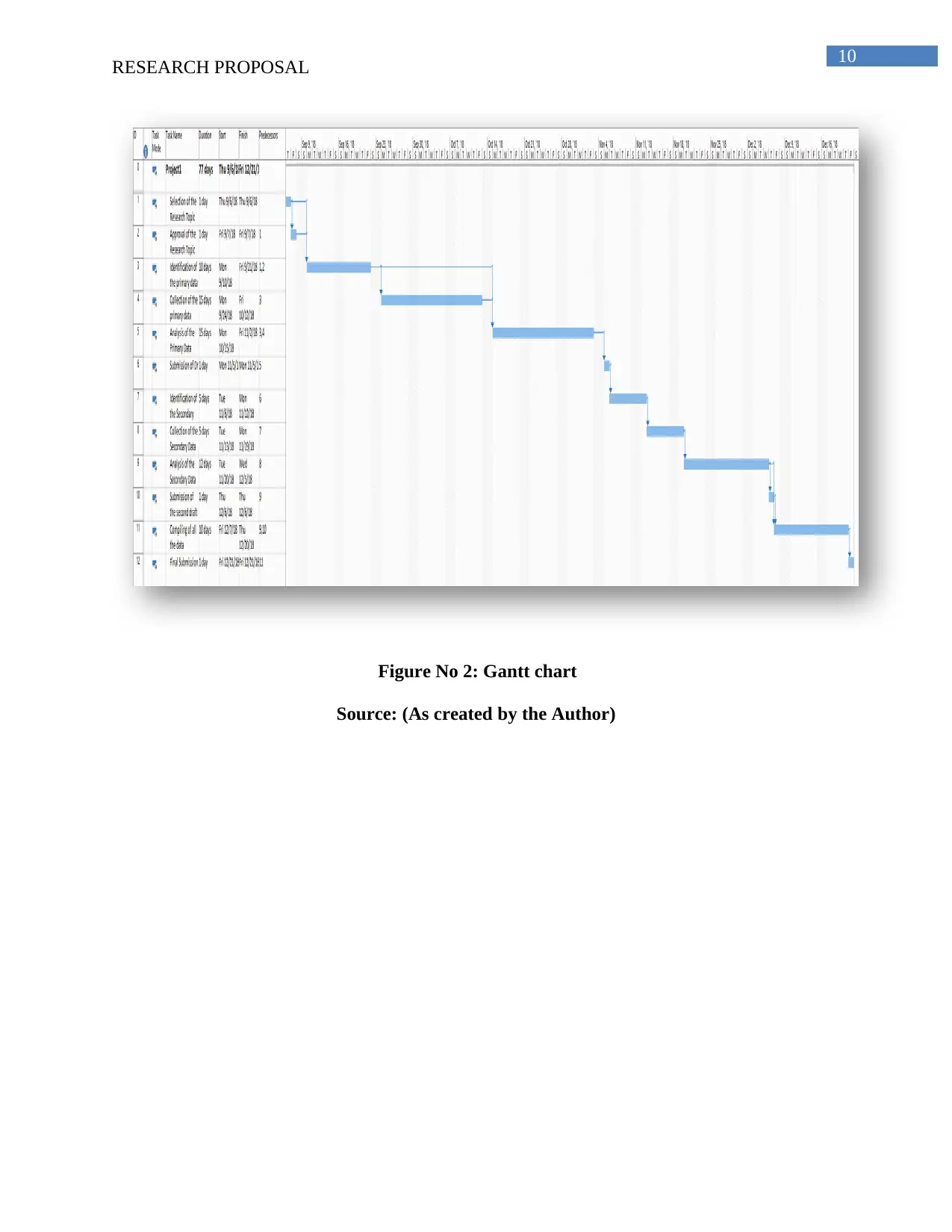
10
RESEARCH PROPOSAL
Figure No 2: Gantt chart
Source: (As created by the Author)
RESEARCH PROPOSAL
Figure No 2: Gantt chart
Source: (As created by the Author)
Secure Best Marks with AI Grader
Need help grading? Try our AI Grader for instant feedback on your assignments.
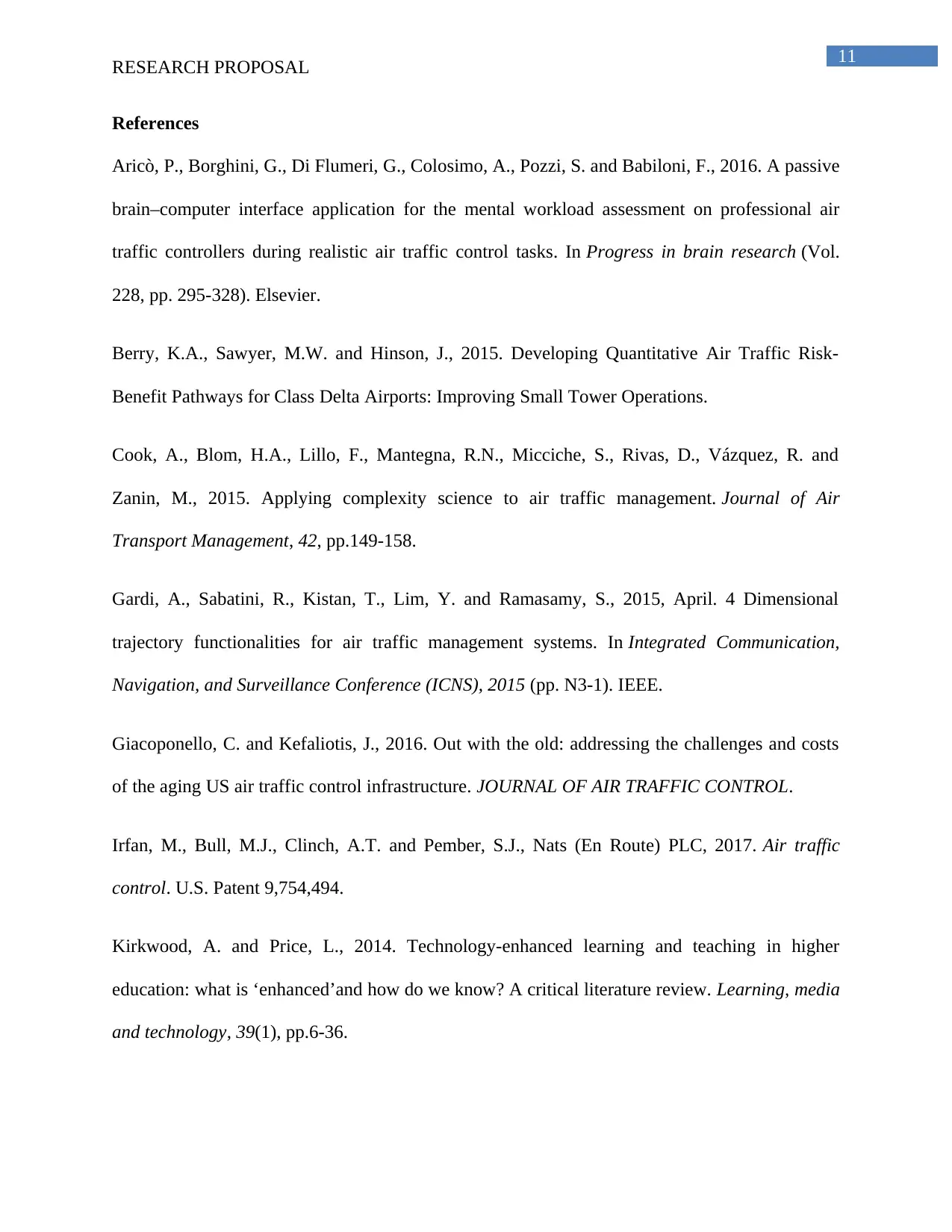
11
RESEARCH PROPOSAL
References
Aricò, P., Borghini, G., Di Flumeri, G., Colosimo, A., Pozzi, S. and Babiloni, F., 2016. A passive
brain–computer interface application for the mental workload assessment on professional air
traffic controllers during realistic air traffic control tasks. In Progress in brain research (Vol.
228, pp. 295-328). Elsevier.
Berry, K.A., Sawyer, M.W. and Hinson, J., 2015. Developing Quantitative Air Traffic Risk-
Benefit Pathways for Class Delta Airports: Improving Small Tower Operations.
Cook, A., Blom, H.A., Lillo, F., Mantegna, R.N., Micciche, S., Rivas, D., Vázquez, R. and
Zanin, M., 2015. Applying complexity science to air traffic management. Journal of Air
Transport Management, 42, pp.149-158.
Gardi, A., Sabatini, R., Kistan, T., Lim, Y. and Ramasamy, S., 2015, April. 4 Dimensional
trajectory functionalities for air traffic management systems. In Integrated Communication,
Navigation, and Surveillance Conference (ICNS), 2015 (pp. N3-1). IEEE.
Giacoponello, C. and Kefaliotis, J., 2016. Out with the old: addressing the challenges and costs
of the aging US air traffic control infrastructure. JOURNAL OF AIR TRAFFIC CONTROL.
Irfan, M., Bull, M.J., Clinch, A.T. and Pember, S.J., Nats (En Route) PLC, 2017. Air traffic
control. U.S. Patent 9,754,494.
Kirkwood, A. and Price, L., 2014. Technology-enhanced learning and teaching in higher
education: what is ‘enhanced’and how do we know? A critical literature review. Learning, media
and technology, 39(1), pp.6-36.
RESEARCH PROPOSAL
References
Aricò, P., Borghini, G., Di Flumeri, G., Colosimo, A., Pozzi, S. and Babiloni, F., 2016. A passive
brain–computer interface application for the mental workload assessment on professional air
traffic controllers during realistic air traffic control tasks. In Progress in brain research (Vol.
228, pp. 295-328). Elsevier.
Berry, K.A., Sawyer, M.W. and Hinson, J., 2015. Developing Quantitative Air Traffic Risk-
Benefit Pathways for Class Delta Airports: Improving Small Tower Operations.
Cook, A., Blom, H.A., Lillo, F., Mantegna, R.N., Micciche, S., Rivas, D., Vázquez, R. and
Zanin, M., 2015. Applying complexity science to air traffic management. Journal of Air
Transport Management, 42, pp.149-158.
Gardi, A., Sabatini, R., Kistan, T., Lim, Y. and Ramasamy, S., 2015, April. 4 Dimensional
trajectory functionalities for air traffic management systems. In Integrated Communication,
Navigation, and Surveillance Conference (ICNS), 2015 (pp. N3-1). IEEE.
Giacoponello, C. and Kefaliotis, J., 2016. Out with the old: addressing the challenges and costs
of the aging US air traffic control infrastructure. JOURNAL OF AIR TRAFFIC CONTROL.
Irfan, M., Bull, M.J., Clinch, A.T. and Pember, S.J., Nats (En Route) PLC, 2017. Air traffic
control. U.S. Patent 9,754,494.
Kirkwood, A. and Price, L., 2014. Technology-enhanced learning and teaching in higher
education: what is ‘enhanced’and how do we know? A critical literature review. Learning, media
and technology, 39(1), pp.6-36.
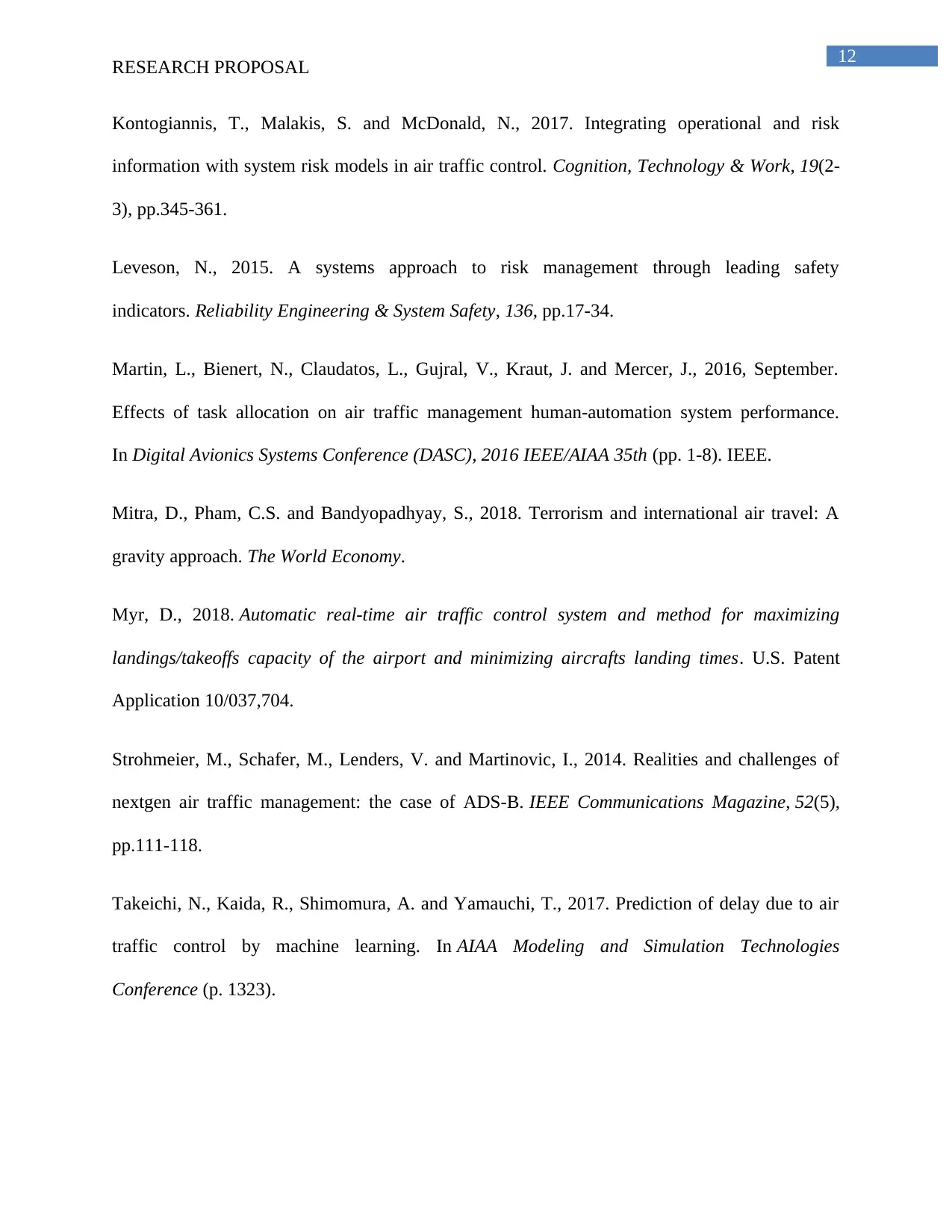
12
RESEARCH PROPOSAL
Kontogiannis, T., Malakis, S. and McDonald, N., 2017. Integrating operational and risk
information with system risk models in air traffic control. Cognition, Technology & Work, 19(2-
3), pp.345-361.
Leveson, N., 2015. A systems approach to risk management through leading safety
indicators. Reliability Engineering & System Safety, 136, pp.17-34.
Martin, L., Bienert, N., Claudatos, L., Gujral, V., Kraut, J. and Mercer, J., 2016, September.
Effects of task allocation on air traffic management human-automation system performance.
In Digital Avionics Systems Conference (DASC), 2016 IEEE/AIAA 35th (pp. 1-8). IEEE.
Mitra, D., Pham, C.S. and Bandyopadhyay, S., 2018. Terrorism and international air travel: A
gravity approach. The World Economy.
Myr, D., 2018. Automatic real-time air traffic control system and method for maximizing
landings/takeoffs capacity of the airport and minimizing aircrafts landing times. U.S. Patent
Application 10/037,704.
Strohmeier, M., Schafer, M., Lenders, V. and Martinovic, I., 2014. Realities and challenges of
nextgen air traffic management: the case of ADS-B. IEEE Communications Magazine, 52(5),
pp.111-118.
Takeichi, N., Kaida, R., Shimomura, A. and Yamauchi, T., 2017. Prediction of delay due to air
traffic control by machine learning. In AIAA Modeling and Simulation Technologies
Conference (p. 1323).
RESEARCH PROPOSAL
Kontogiannis, T., Malakis, S. and McDonald, N., 2017. Integrating operational and risk
information with system risk models in air traffic control. Cognition, Technology & Work, 19(2-
3), pp.345-361.
Leveson, N., 2015. A systems approach to risk management through leading safety
indicators. Reliability Engineering & System Safety, 136, pp.17-34.
Martin, L., Bienert, N., Claudatos, L., Gujral, V., Kraut, J. and Mercer, J., 2016, September.
Effects of task allocation on air traffic management human-automation system performance.
In Digital Avionics Systems Conference (DASC), 2016 IEEE/AIAA 35th (pp. 1-8). IEEE.
Mitra, D., Pham, C.S. and Bandyopadhyay, S., 2018. Terrorism and international air travel: A
gravity approach. The World Economy.
Myr, D., 2018. Automatic real-time air traffic control system and method for maximizing
landings/takeoffs capacity of the airport and minimizing aircrafts landing times. U.S. Patent
Application 10/037,704.
Strohmeier, M., Schafer, M., Lenders, V. and Martinovic, I., 2014. Realities and challenges of
nextgen air traffic management: the case of ADS-B. IEEE Communications Magazine, 52(5),
pp.111-118.
Takeichi, N., Kaida, R., Shimomura, A. and Yamauchi, T., 2017. Prediction of delay due to air
traffic control by machine learning. In AIAA Modeling and Simulation Technologies
Conference (p. 1323).
1 out of 12
Related Documents
Your All-in-One AI-Powered Toolkit for Academic Success.
+13062052269
info@desklib.com
Available 24*7 on WhatsApp / Email
![[object Object]](/_next/static/media/star-bottom.7253800d.svg)
Unlock your academic potential
© 2024 | Zucol Services PVT LTD | All rights reserved.





